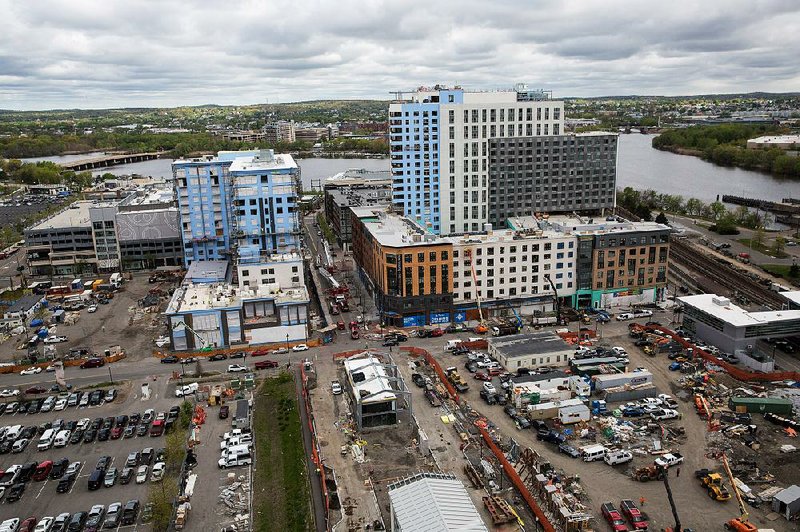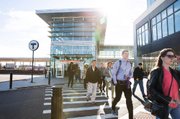Rail stations, it turns out, are delivering much more than passengers to surrounding neighborhoods.
Young workers who prefer to walk or take the train -- rather than drive -- to eat, work and shop are pushing up property values and reshaping the way developers approach their plans.
Few places make this shift more evident than the Somerville suburb of Boston. A new Massachusetts Bay Transportation Authority subway station was crucial to bringing Partners HealthCare to a new 825,000-square-foot office building at the Assembly Row complex last year, said Chris Weilminster, the president for the mixed-use division of the developer Federal Realty Investment Trust.
The station, which opened in 2014, has also driven Federal Realty's broader development of Assembly Row, which broke ground in 2012. The trust has transformed a 45-acre industrial site -- a barren expanse of broken concrete and scrub -- into a neighborhood where housing, offices and restaurants rub shoulders along streets intended to be inviting to pedestrians. Public spaces throughout the development bump up against the Mystic River shoreline.
A second, $280 million phase will add commercial space and homes, including condominiums on top of a boutique hotel.
"You can't underestimate the importance that the investment in transit infrastructure has had," Weilminster said. "Assembly Row would not be what it is today without the station. We wouldn't have built it."
Putting a commercial development near a rail station also reduces the need to build parking, which can be costly. And even millennials who do not use the train may not require a parking space; many are indifferent toward car ownership, particularly given the rise of taxi and car service technologies like Uber and Zipcar.
Such trends give transit-oriented developments an edge over traditional suburban office parks when companies are searching for space, real estate experts say.
The growing number of transit-oriented developments has spurred rail projects in markets of all sizes. Areas that have experienced development near new rail systems or station openings include Fulton Market in Chicago; downtown Kansas City, Mo.; Austin, Texas; and the RiNo neighborhood of Denver, to name a few.
"Clearly, any sort of big transit infrastructure program can act as a huge stimulus for the development of surrounding real estate," said Scott Homa, a director of U.S. office of research for Jones Lang LaSalle, a global property company. "It's starting to emerge as a universal theme across the U.S."
Office buildings with access to transit are outshining those without, fetching rents nearly 80 percent higher. That amounts to $45.57 a square foot versus $25.39 a square foot, according to a report released this year by Jones Lang LaSalle. Those same buildings have a vacancy rate 3.7 percentage points lower than offices without transit access.
"It's definitely a factor when tenants are making their final choice," said E. Nelson Mills, the chief executive of Columbia Property Trust, a New York-based landlord that owns about 7.8 million square feet of office space, primarily in New York, San Francisco and Washington.
A case in point is Columbia Property's $3 million renovation of the 80 M Street building near the Navy Yard-Ballpark Metrorail station in Washington's fast-growing Capitol Riverfront neighborhood. The upgrade follows about 84,000 square feet of new leases, including a 15-year, 68,673-square-foot deal with the shared and private office provider WeWork.
The industrial Fulton Market neighborhood in the West Loop of Chicago began developing a reputation as a vibrant residential, restaurant and bar scene about a decade ago. But investment in the area accelerated when the Chicago Transit Authority said it would open an elevated train station along an existing line in 2012.
Developers swooped in to add offices in new and rehabilitated buildings. Google and Uber are among the companies that have moved into the neighborhood over the past several months, and McDonald's announced last year that it would move its headquarters there from the suburb of Oak Brook.
"Fulton Market is clearly the shining star in Chicago right now," said Todd M. Caruso, a senior managing director of the real estate company CBRE Group. "I'm sure we'll be hearing of more major companies moving there in the coming months."
Corporations in the Northwest are also gravitating to submarkets served by transit. In September, Weyerhaeuser, a timberlands company, traded its 425-acre campus in a Seattle suburb for a new building downtown that is three blocks from a transportation hub. Citing transit opportunities, the outdoor-gear retailer REI also announced that it would move into new headquarters in the growing mixed-use Spring District of Bellevue, Wash., in 2020, just a few years before a Sound Transit light rail station opens there.
Bert Gregory, a partner with the architecture firm Mithun, which designed the new Weyerhaeuser headquarters and is working on apartments in the Spring District, recalled a conversation a few years ago in which a developer told him that rail stops had replaced intersecting freeways as "100 percent" sure-to-succeed locations.
Noting the developer's prescience, Gregory said he had recently realized that all of his active projects were within two blocks of transit lines. One of those includes turning the site of The Oregonian's former printing press buildings into housing, as part of a mixed-use project just outside downtown Portland.
"Transit is the nature of development interest and of developer focus today," he said.
SundayMonday Business on 05/28/2017


